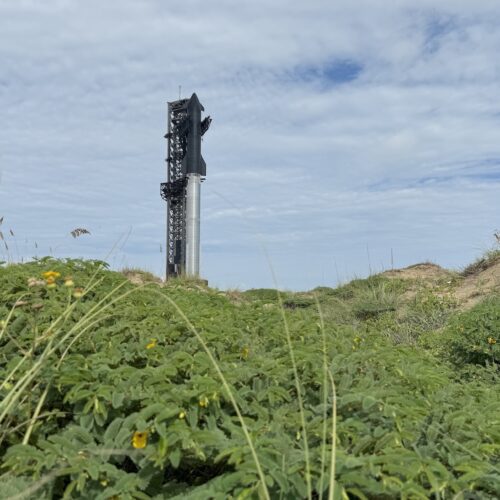
SpaceX’s highly anticipated test flight of its second-generation Starship has been postponed due to a ground system issue, leaving enthusiasts and stakeholders awaiting further updates on a new launch schedule.
Overview of the Starship Program
SpaceX’s Starship program represents a significant leap in aerospace technology, with the vehicle designed to transport humans and cargo to destinations beyond Earth, including the Moon and Mars. The Starship is notable for its size and capabilities, standing at an impressive 404 feet (123.1 meters) tall, making it the largest rocket ever constructed.
The Starship is part of SpaceX’s broader vision to make space travel more accessible and sustainable. With its fully reusable design, the Starship aims to reduce the cost of launching payloads into orbit and beyond, thereby facilitating a new era of space exploration.
Details of the Recent Launch Attempt
This past weekend, a large gathering of aerospace technicians, construction workers, and spaceflight enthusiasts converged on SpaceX’s launch site in Starbase, Texas, in anticipation of the next test flight. The launch was scheduled for a one-hour window starting at 6:30 PM CDT (7:30 PM EDT; 23:30 UTC) on Sunday evening. However, approximately one hour before the scheduled liftoff, SpaceX made the decision to abort the launch attempt.
Reason for the Launch Delay
The company cited a ground system issue as the reason for postponing the flight. While specific details regarding the nature of the problem were not disclosed, such issues can range from technical malfunctions in launch infrastructure to concerns about safety protocols. SpaceX has a history of conducting thorough investigations before proceeding with launches, prioritizing safety and reliability.
Next Steps and Potential Reschedule
SpaceX has not yet confirmed a new date for the launch, but sources indicate that another attempt could occur as soon as Monday evening, maintaining the same launch window. The company’s rapid response to such delays is indicative of its commitment to advancing the Starship program while ensuring all operational aspects are meticulously addressed.
Historical Context of Starship Development
The Starship program has undergone several phases of testing and development since its inception. Initially, prototypes were built and tested for various flight capabilities, including high-altitude flights and landing maneuvers. Each test has provided valuable data, allowing SpaceX to refine the design and functionality of the rocket.
Key milestones in the Starship program include:
- SN1 to SN15 Prototypes: These prototypes underwent a series of tests, including static fires and high-altitude flights, with varying degrees of success. Notably, the SN15 prototype successfully completed a high-altitude flight and landing in May 2021, marking a significant achievement for the program.
- Orbital Flight Tests: The current phase aims to validate the Starship’s capabilities for orbital flights, which are essential for its intended missions to the Moon and Mars.
Implications of the Starship Program
The success of the Starship program carries significant implications for both SpaceX and the broader space industry. By establishing a reliable and cost-effective means of launching payloads, SpaceX could reshape the landscape of space exploration and commercial satellite deployment.
Impact on Future Missions
NASA has already partnered with SpaceX for its Artemis program, which aims to return humans to the Moon by the mid-2020s. The Artemis missions will rely on the Starship for lunar landings, making the successful development and testing of the rocket critical for achieving these ambitious goals.
Commercial Opportunities
The potential for commercial applications of the Starship is vast. As the rocket is designed to carry large payloads, it opens the door for new business models in satellite deployment, space tourism, and interplanetary exploration. Companies and governments looking to establish a presence in space may find the Starship an attractive option due to its reusability and capacity.
Challenges Ahead
Despite the promising outlook, the path forward for the Starship program is not without challenges. Technical hurdles, regulatory approvals, and the need for rigorous safety testing all pose significant obstacles. SpaceX must navigate these challenges while maintaining its ambitious timeline for future launches.
Regulatory Considerations
SpaceX operates under the jurisdiction of the Federal Aviation Administration (FAA), which oversees commercial spaceflight activities. The FAA’s role includes ensuring that launches comply with safety regulations and environmental considerations. As SpaceX prepares for future launches, it must work closely with the FAA to secure the necessary permits and approvals.
Technical Hurdles
Each test flight provides critical data that informs design improvements, but technical issues can arise unexpectedly. The recent ground system issue serves as a reminder of the complexities involved in aerospace engineering. SpaceX’s ability to troubleshoot and resolve these issues efficiently will be crucial in maintaining momentum for the Starship program.
Community and Industry Response
The aerospace community and space enthusiasts have closely followed the development of the Starship program, often gathering at the launch site to witness test flights. The excitement surrounding these events reflects a growing interest in space exploration and the potential for new technologies to emerge from the program.
Moreover, the involvement of local communities in South Texas has been notable, with many residents expressing support for SpaceX’s presence in the region. The economic impact of SpaceX’s operations has been significant, creating jobs and fostering a culture of innovation in the area.
Looking Ahead
As SpaceX continues to refine the Starship and prepare for future test flights, the anticipation surrounding the program remains high. The next launch attempt, whether it occurs on Monday or at a later date, will be closely watched by industry experts, government officials, and space enthusiasts alike.
In conclusion, the Starship program stands at a critical juncture, with the potential to revolutionize space travel and exploration. While recent delays may pose challenges, they also provide opportunities for SpaceX to ensure that the vehicle is fully prepared for its ambitious missions.
Source: Original reporting
Was this helpful?
Last Modified: August 25, 2025 at 10:49 am
0 views


![What Google Material 3 Expressive redesigns are rolling out [Updated]](https://www.hashe.com/wp-content/uploads/2025/08/Material-3-Expressive-Google-apps-2.jpg)












